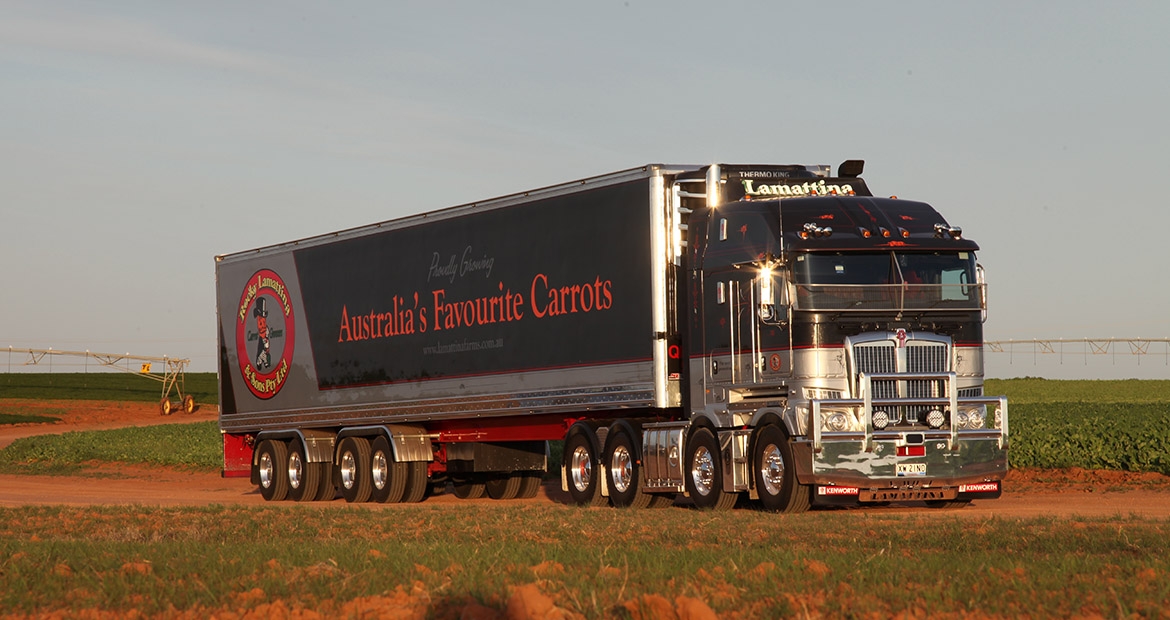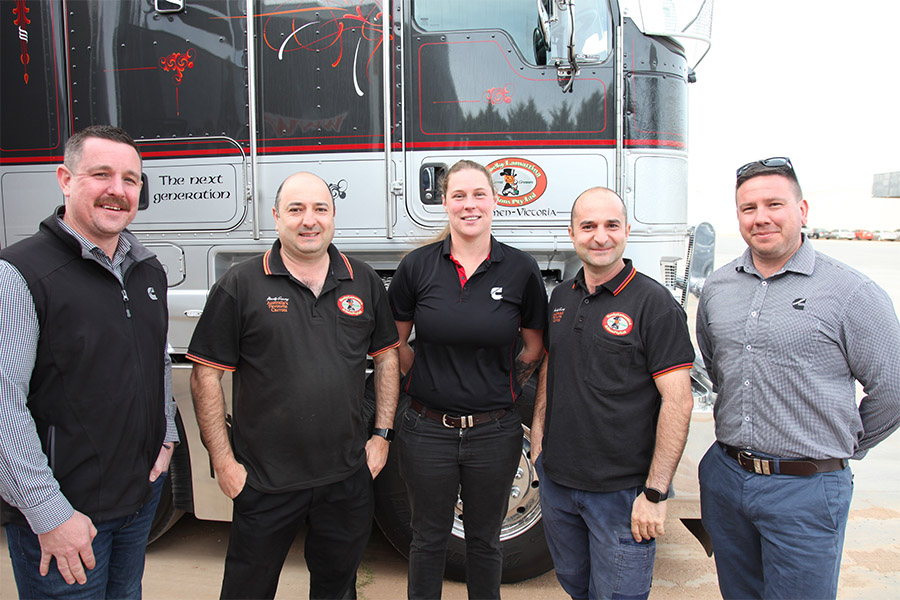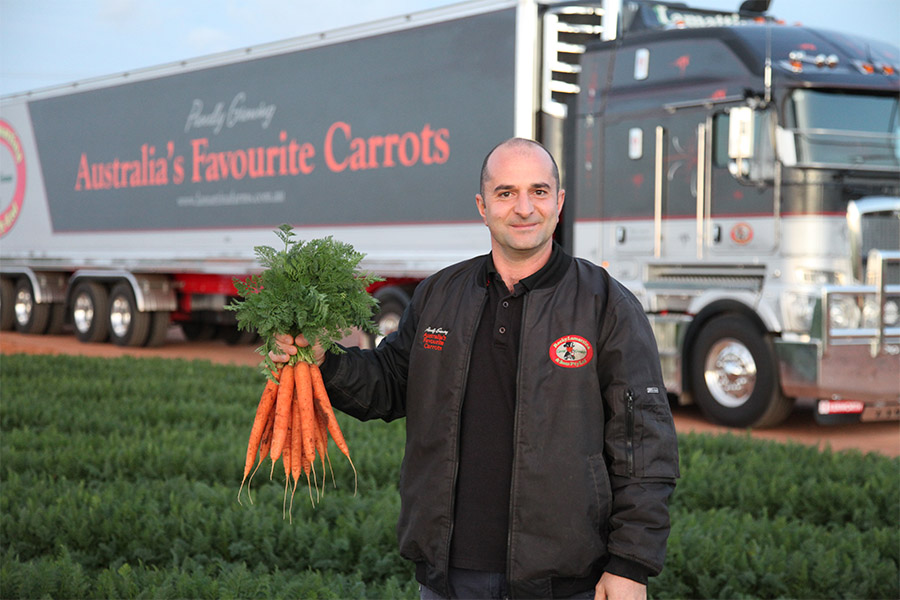Carrot King calls the shots: Powering haulage efficiencies to new levels
By Cummins Inc., Global Power Technology Leader

Rocky Lamattina & Sons is big business, and its headquarters in Wemen in northern Victoria, needs to be seen to be believed.
It’s a world-class family-owned operation, processing around 1000 tonnes of carrots every week for delivery to supermarkets as well as wholesale and export markets.
All the transport is carried out by the Lamattinas’ own fleet of 16 Cummins Inc. X15-powered Kenworths pulling trailers splashed with the motto ‘Australia’s Favourite Carrots’.
The fleet is kept busy 52 weeks of the year, running like clockwork, as harvesting is carried out at the Lamattinas’ three properties, Wemen and Kaniva in Victoria and St George in southern Queensland.
The carrots are then trucked back to Wemen HQ where they are washed, graded and packed using the latest process technologies from around the world.
Establishing year-round growing capacity at different geographical locations has been key to the family’s success – success that has been forged over 33 years by Rocky Lamattina, wife Kathy, and sons Angelo, Phil, John and the team.
While the core focus of the business is still carrots, the Lamattinas are in the process of diversifying by establishing a pistachio farm, spurred on by rising demand for the nut from Australian consumers.

Buying the best
Discussing the company’s vast array of farming and transport equipment, John Lamattina is clear about the family’s priorities.
“Our philosophy has always been to buy the best, utilise it to its full capacity, maintain it properly and then replace it when it’s done,” he states.
“Having our own truck fleet gives us the flexibility to deliver carrots from harvest to supermarket shelves in less than 24 hours,” he adds. “We’ve looked a number of times at sub-contracting out our transport but we’ve always come to the conclusion that we can do it more efficiently ourselves.
“Carrots are the cheapest vegetable on the shelves and that hasn’t changed in 30 years. Our only option has been to become more efficient.”
He insists that trucks should be able to do 900,000 to one million kilometres trouble-free and that this expectation is not an over-reach but a realistic assessment when purchasing, at high cost, premium equipment.
High productivity
John credits brother Angelo with the design concepts that now see the company running innovative high productivity vehicles that have attracted international interest.
These include five B-quads, a Stag B-triple and (at the time of writing) four 30-pallet single-trailer units pulled by twin-steer Kenworths – two K200s and two K220s – all powered by Cummins X15 Euro 5 engines rated at 600 hp with peak torque of 2050 lb ft, the standard rating for the entire fleet.
By early next year, the Lamattinas will have seven of the 30-pallet units running at a gross weight of 62 tonnes over a length of 22.5 metres, replacing 32-pallet B-doubles.
The quad-axle arrangement under the 18.3-metre Southern Cross fridge vans is actually two separate bogies with a total weight allowance of 34 tonnes (17 tonnes-per-bogie).
“We’ve got the same payload as our 32-pallet B-doubles but have one less fridge motor, one less axle, reduced tyre costs, improved fuel consumption and life is easier for the drivers because they don’t have to disconnect and connect and don’t have to back up two trailers,” says John.
A noticeable aspect of all the new combinations is the absence of converter dollies, Angelo Lamattina noting they are redundant due to the company’s specific operational requirements as well as a focus on greater stability.
The five B-quads, which haul the harvested carrots from the St George and Kaniva farms to Wemen for processing, are essentially three A-trailers coupled to a B-trailer which operate at 107 tonnes gross with a payload of 74 tonnes.
The Stag B-triple tipper combination comprises a short last trailer that connects to a B-double via a fifth wheel. The unit, which carries a 59-tonne payload at a GVM of 95.5 tonnes, delivers gypsum and cow manure (collected from feedlots) to the farms and delivers grain to Lamattina customers.

Cummins support
Cummins’ branches in Victoria’s Riverland region, at Mildura and Swan Hill, have forged a strong relationship with the Lamattinas.
As head of the transport operation, John Lamattina came up with a good idea recently to further underpin Cummins’ position as a key supplier to Lamattina & Sons.
“I was invited to the Swan Hill branch to talk to everyone about our operation but I thought it would be better if all Cummins staff from Mildura and Swan Hill visited our facility and we could show them exactly how we go about our business and the pressures we encounter on a daily basis,” he says.
That happened over two days and so as not to cause disruption to branch operations, half the staff from Mildura and Swan Hill visited the Lamattina facility one day, and the other half the next day.
“The feedback from the branch teams was fantastic,” says John, a sentiment confirmed by Cummins regional branch manager Jackson Meredith. “Our goal as a region is making sure everyone at our branches, not just a select few, are fully aware of our customers’ operations, what they do, how they do it and how we play a crucial role in the success of their business.
"We are recognised for delivering top-tier support in our industry, and to maintain that standard we need to ensure our operational and communication systems are well established."
Rocky’s story
The Lamattina story is indeed a remarkable one: Rocky came to Australia from Italy in the early 1950s as a three-year-old and his family bought their first Australian farm – a mere three-hectare lot – in Clayton, a suburb of Melbourne, in the early 1960s.
Rocky, Kathy and their sons started their own business in Wemen in 1991 with 500 acres of land which had sheep grazing on it at the time of purchase. After initially growing broccoli, potatoes and carrots, the decision was made to focus on just one crop and become very good at it. That crop was carrots.
The rest, as they say, is history.
Author Profiles

Cummins Inc., Global Power Technology Leader
Cummins Inc., a global power leader, is committed to powering a more prosperous world. Since 1919, we have delivered innovative solutions that move people, goods and economies forward. Our five business segments—Engine, Components, Distribution, Power Systems and Accelera™ by Cummins—offer a broad portfolio, including advanced diesel, alternative fuel, electric and hybrid powertrains; integrated power generation systems; critical components such as aftertreatment, turbochargers, fuel systems, controls, transmissions, axles and brakes; and zero-emissions technologies like battery and electric powertrain systems and electrolyzers. With a global footprint, deep technical expertise and an extensive service network, we deliver dependable, cutting-edge solutions tailored to our customers’ needs, supporting them through the energy transition with our Destination Zero strategy. We create value for customers, investors and employees and strengthen communities through our corporate responsibility global priorities: education, equity and environment. Headquartered in Columbus, Indiana, Cummins employs approximately 70,000 people worldwide and earned $3.9 billion on $34.1 billion in sales in 2024.
Related Topics
Related Tags